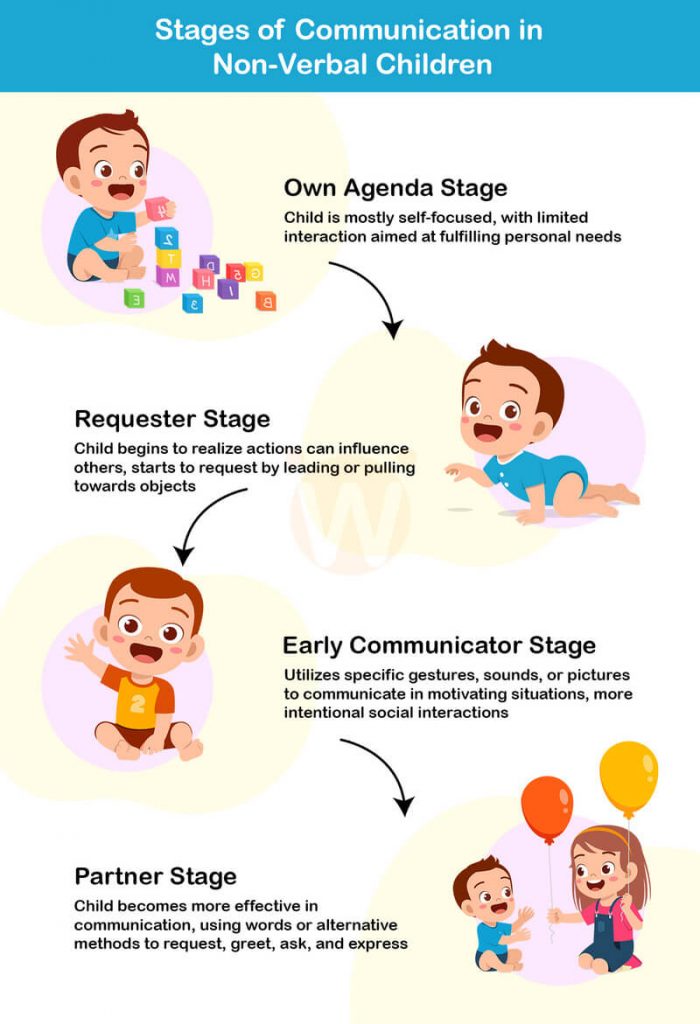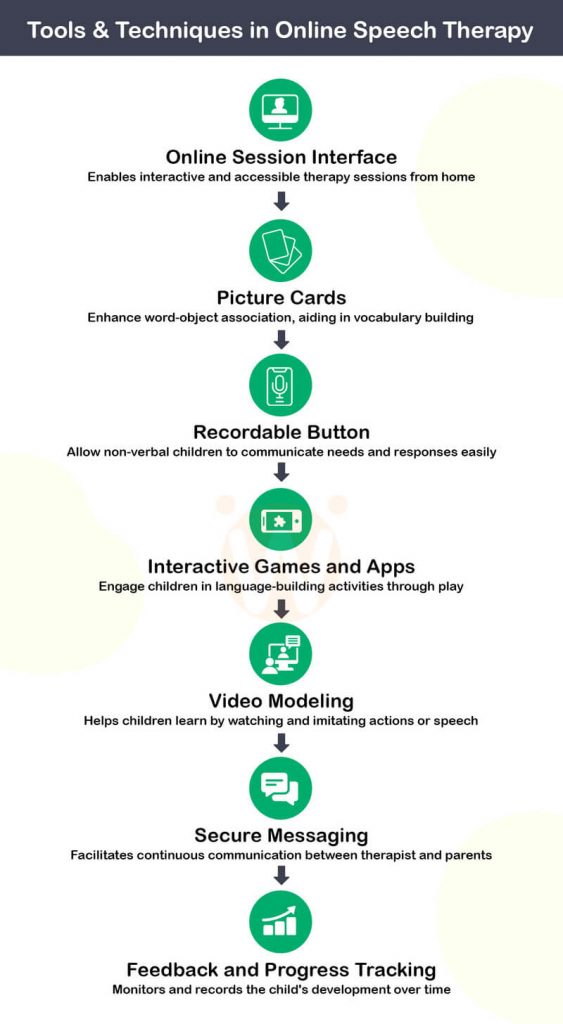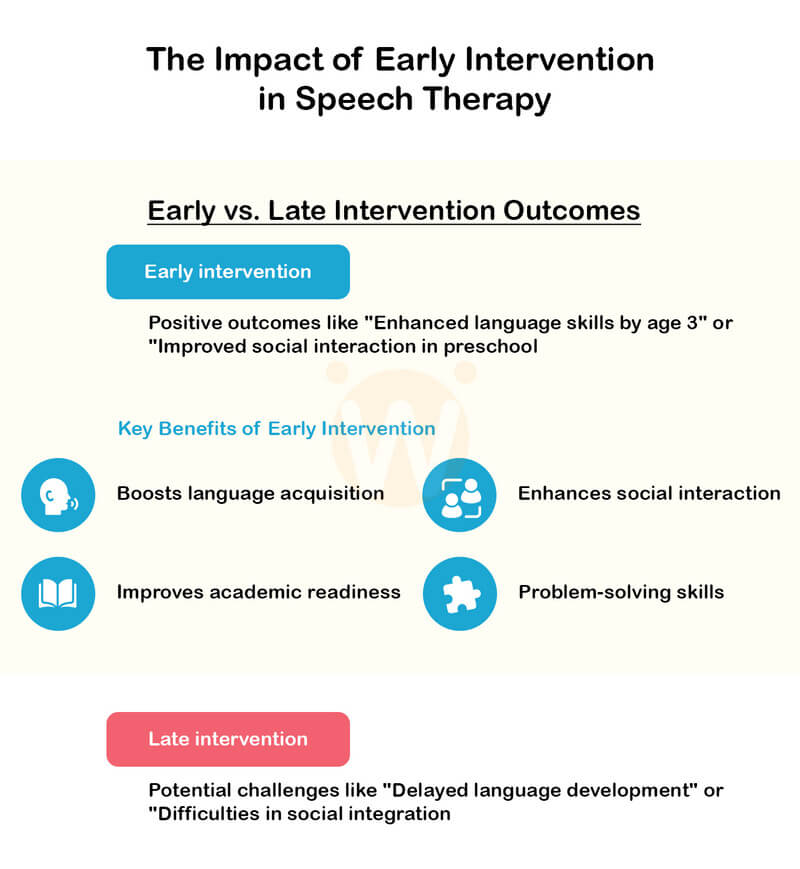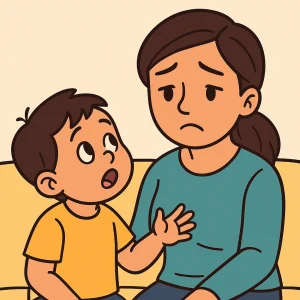Navigating Online Speech Therapy for Non-Verbal Children: A Guide for Parents and Educators
By Rajini D
Last Updated: December 14, 2023
Navigating the world of communication can be a unique challenge for non-verbal children, particularly those on the Autism spectrum. These children often possess a deep well of potential and intelligence, yet struggle to express themselves due to their inability to use verbal speech. The implications of this communication barrier can be profound, impacting their social interactions, learning, and overall development.
Recognizing the critical role of early and appropriate interventions, speech therapy emerges as a vital tool in bridging this communication gap. Traditional speech therapy has long been a cornerstone in supporting these children. However, with advancements in technology and changing lifestyles, online speech therapy has become an increasingly viable and effective option. This innovative approach not only offers flexibility and accessibility but also opens up new avenues for customized, child-centric communication strategies.
For a deeper understanding of speech and language milestones in children, visit our detailed guide here.
Understanding Non-Verbal Children
To effectively support non-verbal children, it’s crucial to understand their unique communication journey, which often unfolds in various stages:
- The Own Agenda Stage: At this initial stage, children are primarily focused on their own interests and needs. They might engage in limited interaction, mainly to fulfill their desires or in response to highly motivating situations.
- The Requester Stage: Here, children begin to realize their actions can influence others. They might start requesting things through actions like pulling or leading an adult to an object.
- The Early Communicator Stage: This stage sees children using specific gestures, sounds, or even words in certain situations. Their social interactions become more intentional and prolonged.
- The Partner Stage: At this advanced stage, children become more effective communicators. They start participating in longer interactions, use various methods to communicate (like words, gestures, or alternative methods), and even begin to express feelings or talk about past and future events.
Identifying which stage a child is in is crucial for setting realistic and effective communication goals. By understanding their current abilities and challenges, parents and therapists can tailor their approaches to suit the child’s specific needs, ensuring that each step in their communication development is nurtured appropriately.

As we delve deeper into the nuances of speech therapy for non-verbal children, it’s important to remember that each child’s journey is unique. Their paths to finding their voice, whether through spoken words or alternative communication methods, are as diverse as their personalities. In the upcoming sections, we’ll explore how online speech therapy can be a game-changer in this journey, offering tools and strategies tailored to each child’s needs and circumstances.
To learn more about Autism Spectrum Disorder and its impact on communication, explore our resource here.
Effective Strategies in Online Speech Therapy
In the dynamic realm of online speech therapy, a variety of strategies are employed to foster communication skills in non-verbal children. These methods are not only effective but can be seamlessly integrated into a child’s daily routine, making learning both fun and practical.

1. Imitation of Actions
One of the foundational strategies in speech therapy is teaching children to imitate actions. This could involve mimicking simple hand gestures or facial expressions. Online platforms allow therapists to demonstrate these actions through video, which children can then replicate. This method helps in building motor skills and understanding the concept of mimicry, which is crucial for language development.
2. Turn-Taking and Requesting
Online sessions can also focus on turn-taking activities. This is done using digital games or interactive sessions where a child learns to wait for their turn and understand the sequence of events. Simultaneously, children are encouraged to make requests, either through verbal means or alternative communication methods like gestures or picture cards.
3. Use of Picture Cues
Picture cues play a significant role in online speech therapy. These visual aids help in enhancing comprehension and communication. Children learn to associate pictures with words or actions, aiding in vocabulary development and sentence formation.
4. Following Multi-Step Directions
Therapists use interactive digital tools to teach children how to follow multi-step instructions. This could involve a series of tasks that a child needs to complete, enhancing their ability to process and follow through on given directions.
5. Improving Imitation Skills
Imitation is a critical skill in speech development. Online platforms provide a range of activities like singing, storytelling, or play-acting, where children are encouraged to imitate sounds, words, and phrases.
By integrating these strategies into daily routines, children can practice and reinforce their communication skills in a natural, stress-free environment. For example, using picture cues during mealtime or turn-taking games during playtime can make learning an enjoyable part of their day.
Discover how our online speech therapy program can be a transformative experience for your child here.
Comparison of Traditional vs. Online Speech Therapy
| Feature | Traditional Therapy | Online Therapy |
|---|---|---|
| Accessibility | Often requires travel to a clinic, which can be challenging for some families. | Accessible from home, reducing travel time and making scheduling easier. |
| Flexibility | Sessions are usually scheduled during clinic hours, which may not always be convenient. | Offers more flexible scheduling, including potential for evening or weekend sessions. |
| Tools Used | Relies on physical tools and direct interaction, which can be effective but limited to the clinic’s resources. | Utilizes digital tools and resources, offering a wide range of interactive and engaging activities. |
| Parent Involvement | Parents are typically involved in the therapy process, but their role might be more observational during sessions. | Encourages active parent participation, as therapy is conducted in the home environment. |
| Environment | Conducted in a professional setting, which can be less familiar to the child. | Takes place in the child’s own environment, which can be more comfortable and less intimidating. |
| Customization | While personalized, the therapy may follow a more standardized approach due to the clinic’s protocols. | Highly customizable, with therapy sessions tailored to the child’s specific needs and home environment. |
| Technology Integration | Limited to the equipment available in the clinic. | Makes extensive use of modern technology, including apps and online resources, for interactive learning. |
| Feedback and Monitoring | Regular feedback typically provided in face-to-face meetings with parents. | Continuous and real-time feedback often available through online platforms, with progress tracking features. |
| Peer Interaction | Group therapy sessions offer peer interaction, which can be beneficial for social skills development. | Online group sessions may be available, but peer interaction could be less direct compared to in-person settings. |
For more insights into the benefits of online speech therapy, particularly in the context of Hyderabad, check out our detailed analysis here.
The Role of Technology in Speech Therapy
Technology has revolutionized the way speech therapy is delivered, especially in the online context. The use of various technological tools has made therapy sessions more interactive, engaging, and effective.
- Secure Texting with Therapists: Many online speech therapy platforms offer secure messaging features. This allows for continuous communication between the therapist and the parents, enabling them to discuss progress, address concerns, and plan future sessions.
- Weekly Therapy Exercises: Customized exercises and activities are provided to children on a weekly basis. These exercises are designed to reinforce the skills learned during therapy sessions and can be accessed anytime, making practice convenient and consistent.
- Recordable Button Switches: These devices are particularly useful for children who are non-verbal. They can record and play back messages, enabling children to communicate their needs and responses. It’s a great tool for enhancing interaction and participation.
- Tracking Progress: Technology also plays a crucial role in monitoring a child’s progress. Online platforms often have features that allow therapists and parents to track improvements, set goals, and adjust strategies as needed.
At Wellness Hub, we understand the transformative power of these technological tools in speech therapy. By leveraging technology, we aim to provide children with the best possible support on their communication journey. For more information on how technology is integrated into our speech therapy sessions, visit our TELE BASICS – A Synchronized Whiteboard from Wellness Hub page.
Total Communication Approach
The Total Communication Approach in speech therapy is a comprehensive method that caters to the diverse communication needs of non-verbal children, particularly those with Autism. This approach goes beyond verbal language, incorporating prelinguistic skills such as gestures, facial expressions, and eye gaze. These non-verbal cues play a crucial role in the early stages of communication development and are especially beneficial for children who may not use spoken words as their primary form of communication.
In this approach, pictures and real objects are utilized extensively. They act as visual aids, helping children to associate images with words or actions, thus facilitating understanding and expression. For instance, showing a picture of a food item can help a child express their choice without needing to verbalize it.
Another effective tool in the Total Communication Approach is the use of simple recordable buttons. These buttons can be programmed with messages, allowing children to communicate their needs and responses with a simple press. This not only aids in communication but also empowers the child by giving them a sense of control and independence in their interactions.
Understanding each child’s unique way of communicating is central to this approach. It recognizes that every child has their own set of strengths and challenges, and communication strategies should be tailored to fit their individual needs.
Read about our comprehensive approach to Autism treatment in Hyderabad here for more information on how we tailor therapy to each child’s needs.
Focus Areas and Exercises in Speech Therapy for Non-Verbal Autism
In speech therapy for non-verbal autism, there are several key focus areas:
- Encouraging Social Interactions: Therapists work on exercises that encourage children to interact socially. This includes participating in group activities, understanding social cues, and engaging in play with peers or family members.
- Enhancing Understanding of Spoken Language: Activities are designed to help children comprehend spoken language. This might involve simple instructions, recognizing common words, or understanding routine-based verbal cues.
- Building Communication Skills: The emphasis is on developing various forms of communication, whether it be through signs, symbols, or alternative communication devices.
Examples of speech therapy exercises include:
- Journaling: Children are encouraged to express their thoughts and feelings through drawing or writing in journals. This helps in developing their ability to express themselves and can be a stepping stone to more complex forms of communication.
- Name Games: These games are designed to help children recognize and respond to their names. This simple yet crucial skill is fundamental in building their understanding of self and others.
Learn about the innovative techniques we use in our online speech therapy, such as TELE BASICS, here
Speech Therapy Exercises for Non-Verbal Autism
| Exercise | Description | Targeted Skill |
|---|---|---|
| Journaling | Encourages children to express thoughts and feelings through drawing or writing in a journal. | Expression, Conceptualization, Writing Skills |
| Name Games | Games designed to help children recognize and respond to their names. | Listening, Recognition, Response to Stimuli |
| Picture Cues | Uses images to convey meaning or to associate words with objects/actions. | Comprehension, Vocabulary, Association |
| Turn-Taking Games | Activities where the child learns to wait and take turns, often through digital or physical games. | Social Skills, Patience, Sequential Understanding |
| Imitation Activities | Engaging the child in mimicking actions, sounds, or words. | Speech Production, Motor Skills, Auditory Processing |
| Gesture-Based Communication | Incorporates gestures or sign language to communicate needs or responses. | Non-Verbal Communication, Motor Coordination |
| Role-Playing | Involves scenarios or role-play to encourage verbalization and interaction. | Social Interaction, Verbal Expression, Creativity |
| Sound Repetition | Focuses on repeating sounds or words, often with the aid of visual or auditory cues. | Speech Clarity, Auditory Discrimination, Memory |
| Object Identification | Uses real objects to teach children to identify and name various items. | Vocabulary Building, Object Recognition, Memory |
| Interactive Storytelling | Involves reading or creating stories together, encouraging participation. | Listening, Comprehension, Imagination |
The Importance of Early Intervention and Continuous Support
Early intervention in speech therapy is pivotal for children with communication challenges. Research consistently shows that the earlier the intervention begins, the better the outcomes for the child. This is especially true for non-verbal children, including those on the Autism spectrum. Early intervention can significantly enhance language development, social skills, and learning abilities, laying a strong foundation for future growth.

The role of parents and educators in this journey cannot be overstated. Continuous support and reinforcement at home and in educational settings are crucial for the success of speech therapy. Parents and educators can implement the strategies and exercises recommended by therapists in everyday activities, ensuring consistency and providing a supportive environment for the child to practice and improve their communication skills.
For further reading on the importance of early intervention in speech therapy and information about School Readiness, visit our informative article here.
Conclusion
This article has explored the various aspects of online speech therapy for non-verbal children, emphasizing the importance of early intervention, the effectiveness of the Total Communication Approach, and the integration of technology in speech therapy. We have highlighted the key strategies used in therapy, including imitation of actions, use of picture cues, and various interactive exercises.
Parents and educators are encouraged to explore online speech therapy as a supportive tool. It offers flexibility, personalized approaches, and the convenience of accessing therapy from home. This approach can play a significant role in enhancing the communication abilities of non-verbal children.
For those seeking more information or support in this area, WellnessHub offers a wealth of resources. Our website provides detailed insights, tools, and guidance for parents and educators navigating the challenges of speech therapy for non-verbal children. To explore these resources, visit WellnessHub.
Frequently Asked Questions for Online Speech Therapy for Non-Verbal Children
1. What is online speech therapy?
Online speech therapy is a method of delivering speech therapy services via internet technology. It involves the use of video conferencing tools to provide real-time therapy sessions with qualified speech therapists.
2. How effective is online speech therapy compared to traditional in-person therapy?
Numerous studies have shown that online speech therapy can be just as effective as traditional in-person therapy for many children. It offers flexibility, accessibility, and often a more comfortable environment for the child.
3. What age is appropriate to start speech therapy for a non-verbal child?
There’s no minimum age to start speech therapy. In fact, early intervention, often starting as young as infancy, is recommended for better outcomes, especially for children showing signs of communication delays.
4. Can parents and educators be involved in online speech therapy sessions?
Absolutely. Parent and educator involvement is encouraged in online speech therapy. They play a crucial role in reinforcing the strategies and exercises introduced during therapy sessions.
5. What are some common strategies used in speech therapy for non-verbal children?
Common strategies include the use of picture cues, imitation of actions, turn-taking, and utilizing assistive technologies like recordable button switches.
6. How does the Total Communication Approach help non-verbal children?
The Total Communication Approach uses a combination of methods including gestures, facial expressions, sign language, and technology to enhance communication. It’s tailored to each child’s unique needs and strengths.
7. What role does technology play in online speech therapy?
Technology in online speech therapy includes tools like secure messaging with therapists, digital exercises, and interactive games, all of which enhance the learning experience and track progress.
8. How can I assess if my child is making progress in online speech therapy?
Progress can be monitored through regular assessments by the therapist, observing improvements in daily communication, and tracking achievements in specific therapy goals.
9. Are there any specific exercises to help non-verbal children in speech therapy?
Yes, exercises like journaling, name games, and structured play activities are often used to enhance communication skills in non-verbal children.
10. Where can I find more resources and support for speech therapy for non-verbal children?
WellnessHub offers a range of resources, support, and information for parents and educators involved in speech therapy for non-verbal children. Visit our website here for more information.
About the Author
Rajini, Speech-Language Pathologist:
Rajini is a dedicated Speech-Language Pathologist with a focus on developmental speech and language disorders in children and rehabilitation in adults. With a passion for helping each individual find their voice, Rajini brings a wealth of experience and a heartfelt approach to therapy. At Wellness Hub, she’s part of a team that values innovation, compassion, and results-driven practices.
Book your Free Consultation Today
Parent/Caregiver Info:
Client’s Details:
* Error Message








